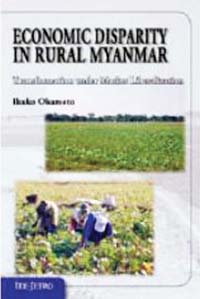Magazine
BOOK REVIEW
Cultivating Inequality
By DAVID SCOTT MATHIESON
JULY, 2008 - VOLUME 16 NO.7
A Japanese study illustrates how farmers created an agricultural market in spite of the military government’s bureaucrats
 |
| Economic Disparity in Rural Myanmar by Ikuko Okamoto. National University of Singapore Press, 2008. P 264 |
The majority of the Burmese labor pool is in farming, and rice production remains not just a national priority but an obsession of the junta. Successive regimes have attempted a number of initiatives to increase agricultural production, first through disastrous socialist policies, and since 1988 with piecemeal open market reforms which have continued to stifle the true promise of the agricultural sector.
Ikuko Okamoto’s book looks at one success story in this sad litany of state failure. Economic Disparity in Rural Myanmar is an academic analysis of the rapid increase in production of pulses in one township close to Rangoon. A pulse is a bean, in this case one called pedishwewar, or golden green gram, otherwise known as the mung bean.
It is a close study of the relationship between Burmese farm laborers, rural traders, tractor dealers, some available land, rice paddy crops and a fortuitous gap in the global rice market that produced a pulse market where before there was none. The sting is that most of the people on the lower rungs—the farmer-laborers—profited least from their labors.
Pulses brought in a total of 3.6 billion kyat (US $3 million) in 2007, mainly due to India, which reduced pulse cultivation, allowing farmers and traders in Burma to fill the demand.
Okamoto, a researcher at Japan’s Institute for Developing Economies, spent several years studying production techniques in Thongwa Township, east of Rangoon and home to 64 villages and about 150,000 people.
In this well-designed and detailed study, she looks at how the dramatic growth in green gram production produced an export success. “This increase was not related to any government policy to promote pulse cultivation…nor were there any coercive measures to expand production,” she writes. It was simply the result of limited reforms which provided the space for farmers to plant the crops for export by local and Rangoon-based merchants. In 20 years, green gram production in Burma, of which Thongwa is the most dramatic example (the government awarded the “outstanding district award for boosting GDP” to Thongwa in 2006), rose from no gram exports in 1980, to 15,000 tons in 1989 and 207,000 tons in 2002. Areas of cultivation of green gram in Thongwa increased from 248 acres in 1986 to 95,000 acres in 2002.
In the process, a minority of people in Thongwa did improve their living standards, mainly farmers who could gain access to credit to purchase or rent tractors. Businesses that rented the tractors also profited, as did export merchants who sold the beans to India. Poor laborers who didn’t have a working title for land couldn’t access credit, which is a rare, yet essential, economic necessity in Burma.
The disparity in income was due to the large worker pool in the area, made up of people who were already poverty stricken and received little payment for a non-labor intensive crop such as green gram.
The author is clear and concise in her criticism of an unwitting government, one that was essentially unaware of green gram production as well as the increasing rates of rural income disparity. Its agricultural policy was based largely on the importance of heavily subsidized and controlled rice production to national stability and self reliance, generating a paranoia that spreads over to other sectors of agriculture and hinders further reform.
There isn’t much of a “human touch” to this book—no human interest narratives or in- depth interviews. Ardeth Maung Thawnghmung’s recent study of paddy farmers and government policy, “Behind the Teak Curtain,” and this year’s excellent report on forced physic nut production in Burma by the Ethnic Community Development Forum, titled “Biofuel by Decree,” make fine reading companions. If it’s details the reader wants, the author provides 115 tables and statistics on everything from tractor fees to annual rainfall in Thongwa.
1 | 2 next page »
more articles in this section
